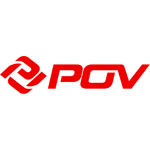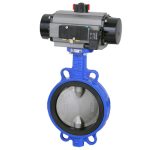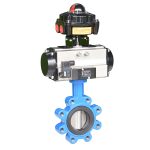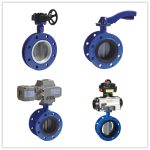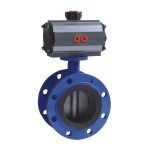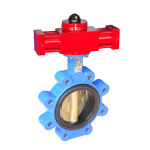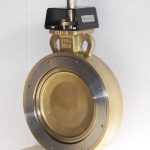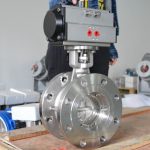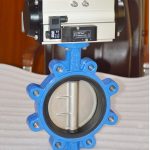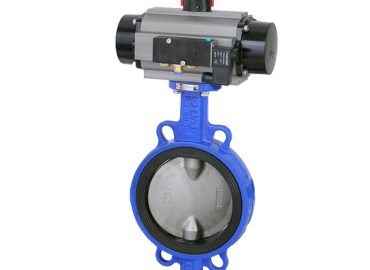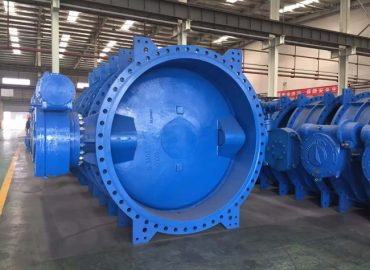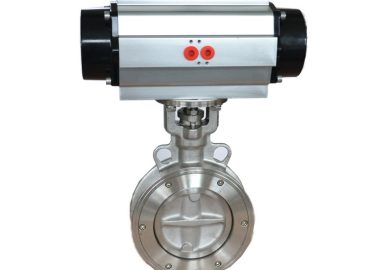Butterfly valve are essential components in various industrial applications, used to control fluid movement effectively. To ensure proper installation and functionality, correct sizing and measurement of the valve’s face to face dimensions are crucial. In this article, we will delve into the standard butterfly valve face to face dimensions, explaining why they are essential, and the factors you should consider when selecting the right valve size. Whether you’re a seasoned professional or a beginner, this guide will provide you with a better understanding of butterfly valves and their dimensions.
Introduction
The standard wafer butterfly valve face to face dimensions refer to the distance between the two flanges of the valve. Typically, this distance varies depending on the size and type of butterfly valve. A general outline of the standard face to face dimensions of typical butterfly valves includes 2 inches for smaller valves and 12 inches for larger valves. However, specific dimensions may vary depending on the manufacturer and the particular application. These dimensions are essential because they ensure proper installation and functionality of the valve, allowing it to fit accurately into the pipeline and operate smoothly. Understanding the standard dimensions, therefore, is crucial when selecting the right valve size.
Explanation of butterfly valves
Butterfly valves are devices used to regulate fluid flow in industrial applications. They consist of a circular disc with a pivot at its center that can be turned 90 degrees to control the flow of fluids. The valve is positioned between two flanges in the pipeline, and opening the valve disc allows fluids to pass through while closing it restricts the flow or shuts it off entirely. Butterfly valves are suitable for applications requiring quick shutoff and low-pressure drop, and their compact design and lightweight construction make them ideal for use in confined spaces. There are different types of butterfly valves, including double offset, triple offset, lug and wafer type valves, each designed for specific uses.
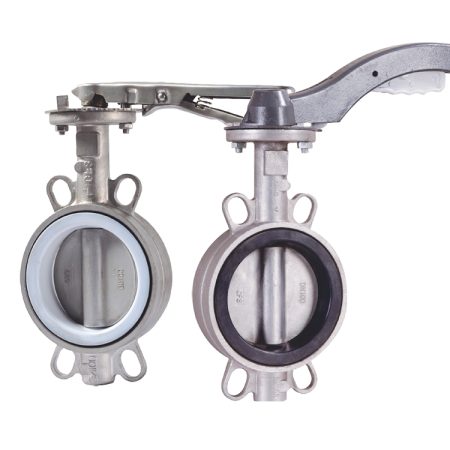
Importance of face to face dimensions in butterfly valves
The face to face dimensions of lug butterfly valve are crucial for ensuring proper valve installation and performance. The distance between the valve flanges determines how tightly it fits into the pipeline, and incorrect dimensions can lead to inefficient operation, leakage, and potential safety hazards. The standard face to face dimensions for butterfly valves vary based on the valve’s size and type, and it’s crucial to select the appropriate valve with the correct dimensions to ensure proper alignment during installation. Correctly sizing the valve will ensure effective sealing, smooth operation, and reduce the risk of costly repairs and maintenance in the long run. Therefore, understanding the significance of face to face dimensions is essential when selecting the right butterfly valve for your application.
Standard butterfly valve face to face dimensions “L”
The standard flanged butterfly valve face to face dimensions “L” depend on the valve’s size and type, and they help ensure correct valve installation and operation. Smaller butterfly valves typically have a face to face dimension of two inches, while larger valves can range up to twelve inches. The American Petroleum Institute (API) outlines standard dimensions for butterfly valves based on flange ratings, and as per industry regulations, manufacturers must follow these guidelines to ensure their products meet the required standards. Specific product variations, such as triple offset or lug type butterfly valves, may have different standard face to face dimensions, so it’s essential to consult with manufacturers’ specifications when selecting the right valve type, size, and face to face dimensions for your application.
| SIZE | A | B | C | D | E | F | d | G | H | L | WT(kg) | |
| DN | INCH | |||||||||||
| 50 | 2″ | 126 | 78 | 13.5 | 94.3 | 9 | 50 | 8 | 70 | 31 | 43 | 2 |
| 65 | 2 1/2″ | 134 | 84 | 13.5 | 107.6 | 9 | 50 | 8 | 70 | 45 | 46 | 2.5 |
| 80 | 3″ | 138 | 92 | 13.5 | 123.9 | 9 | 50 | 8 | 70 | 64 | 46 | 3 |
| 100 | 4″ | 167 | 114 | 13.5 | 157 | 11 | 70 | 10 | 90 | 91 | 52 | 4.5 |
| 125 | 5″ | 180 | 129 | 17.5 | 181.5 | 14 | 70 | 10 | 90 | 110 | 56 | 6 |
| 150 | 6″ | 203 | 144 | 17.5 | 212 | 14 | 70 | 10 | 90 | 146 | 56 | 7 |
| 200 | 8″ | 228 | 179 | 24.5 | 267.4 | 17 | 102 | 12 | 125 | 193 | 60 | 12 |
| 250 | 10″ | 266 | 216 | 25 | 323.6 | 22 | 102 | 12 | 125 | 241 | 68 | 17 |
| 300 | 12″ | 291 | 247 | 25 | 377.4 | 22 | 102 | 12 | 125 | 292 | 78 | 25 |
| 350 | 14″ | 332 | 273 | 30 | 425 | 27 | 125 | 14 | 150 | 329 | 78 | 41 |
| 400 | 16″ | 363 | 317 | 30 | 484 | 27 | 125 | 14 | 150 | 376 | 102 | 58 |
| 450 | 18″ | 397 | 348 | 39 | 537 | 36 | 140 | 18 | 175 | 425 | 114 | 80 |
| 500 | 20″ | 425 | 393 | 39 | 589.5 | 36 | 140 | 18 | 175 | 475 | 127 | 97 |
| 600 | 24″ | 498 | 453 | 49 | 693.1 | 46 | 165 | 22 | 210 | 573 | 154 | 169 |
| 700 | 28″ | 626 | 531 | 90 | 928 | 63.1 | 254 | 18 | 300 | 674 | 165 | 252 |
| 750 | 30″ | 660 | 564 | 90 | 984 | 63.1 | 254 | 18 | 300 | 727 | 165 | 290 |
| 800 | 32″ | 666 | 601 | 90 | 1061 | 63.1 | 254 | 18 | 300 | 771 | 190 | 367 |
| 900 | 36″ | 722 | 660 | 110 | 1170 | 74.7 | 254 | 18 | 300 | 839 | 203 | 465 |
| 1000 | 40″ | 806 | 728 | 120 | 1290 | 83.7 | 298 | 22 | 350 | 939 | 216 | 606 |
| 1100 | 44″ | 826 | 771 | 140 | 1404 | 94.7 | 298 | 22 | 350 | 1036 | 255 | 805 |
| 1200 | 48″ | 941 | 874 | 150 | 1511 | 104.7 | 298 | 22 | 350 | 1137 | 276 | 900 |
| 1400 | 56″ | 1000 | 940 | 175 | 1685 | 139.9 | 356 | 32 | 415 | 1351 | 279 | 1158 |
| 1600 | 64″ | 1155 | 1085 | 195 | 1930 | 160 | 356 | 32 | 415 | 1548 | 318 | 1684 |
| 1800 | 72″ | 1200 | 1170 | 195 | 2170 | 174.5 | 406 | 39 | 475 | 1703 | 356 | 2645 |
| 2000 | 80″ | 1363 | 1360 | 245 | 2345 | 199 | 406 | 39 | 475 | 1938 | 406 | 4000 |
Sizes and dimensions of the valve
Butterfly valves come in various sizes and dimensions, making them versatile and adaptable to different applications. These valves can have a diameter ranging from just a few inches to several feet. The valve’s size and dimensions are critical factors to consider when selecting the appropriate pneumatic butterfly valve for your application. Some factors to consider include the flow rate of the fluid, the pressure, and the required environmental resistance. The dimensions of a particular butterfly valve must be appropriate for its operating environment to avoid operational inefficiencies, safety hazards, and potential equipment failure. Most manufacturers follow industry standards to ensure that their products are compatible with standard piping and flange sizes. Therefore, it’s crucial to select the ideal butterfly valve size and dimensions to guarantee its safe and efficient operation in your application.
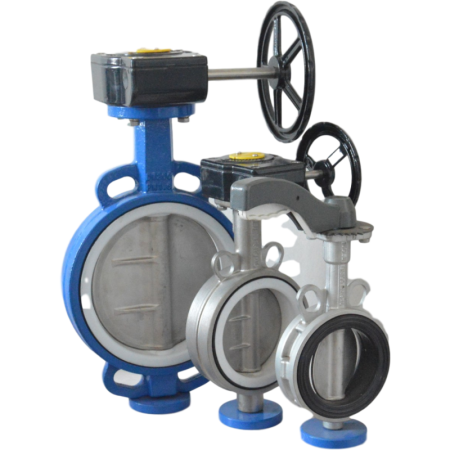
ANSI, API and ISO standards
ANSI, API, and ISO are international standards for the design and manufacturing of industrial valves, including butterfly valves. The American National Standards Institute (ANSI) outlines guidelines for valve face to face dimensions and pressure classes, while the American Petroleum Institute (API) sets quality control standards for industrial valves’ design, fabrication, and inspection. The International Organization for Standardization (ISO) is an international agency that develops technical standards for products and services worldwide. Butterfly valves designed to meet these standards provide high-quality and reliable product, which meets the expected industry requirements in terms of safety, performance, and durability. Adherence to these standards ensures that butterfly valves are suitable for their intended use, and manufacturers must ensure that their products meet these regulations to ensure customer satisfaction and safety.
Importance of standard butterfly valve dimensions
The standard dimensions of butterfly valves ensure interchangeability among different manufacturers, simplify installation procedures, and ensure that the valve performs according to expectations in a particular application. Establishing standard dimensions that comply with industry guidelines for valve size range, materials, pressure classes, and other factors provides a common language for manufacturers, installers, and operators, eliminating confusion and complications that can arise from non-standardized butterfly valves. Furthermore, using butterfly valves that comply with standardized dimensions ensures that specific requirements for fluid flow control are met, avoiding potential operational inefficiencies, safety hazards, and subsequent costs. By adhering to standard dimensions, customers can guarantee that the butterfly valves they purchase will meet the manufacturer’s specifications and perform to their intended design parameters.
Ensuring proper fit and function
Ensuring proper fit and function of butterfly valves is paramount to their successful operation. The correct selection of material, size, and dimensions for the valve is essential for optimal performance. Failing to adhere to standard dimensions or selecting a valve with sub-optimal sizing can result in potential safety hazards due to inadequate sealing or leakage or increased maintenance costs due to premature wear and tear. Proper installation of butterfly valves is also essential to ensure leak-free operation, bearing in mind that various components must be installed in the proper sequence to avoid misalignment, gaskets properly seated, and bolts tightened according to recommended torque specifications. By considering the conditions of the environment, fluid properties, and other relevant factors along with the manufacturer’s specifications, you can ensure proper fit and function of butterfly valves for optimal performance.
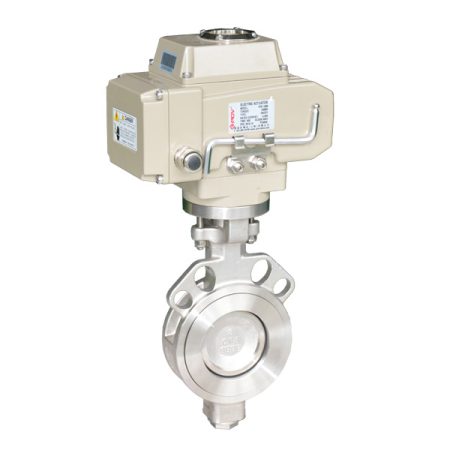
Compatibility within pipelines
Electric Butterfly valve must be compatible with the existing pipeline to ensure optimal performance. The dimensions of butterfly valves must match the dimensions of the pipeline to which they will be installed. Butterfly valves using non-standard dimensions or incompatible with the pipeline will have operational problems such as leaks, inefficiencies in flow control, and potential safety hazards. Therefore, it’s essential to ensure compatibility within the pipeline system, considering factors like pressure, temperature, and fluid medium to guarantee reliable operation of the valve. Compatibility allows seamless integration of butterfly valves into the pipeline system, simplifying installation, and maintenance procedures. By selecting valves that match the pipeline’s specifications, distributors can ensure that their products offer the highest level of performance and reliability.
Avoiding unnecessary downtime and maintenance
To avoid unnecessary downtime and maintenance costs due to butterfly valves, proper sizing, and selection of the valve’s dimensions are essential. Selecting butterfly valves that do not conform to industry standards or are not compatible with the pipeline can result in costly maintenance needs and extended downtime, adversely affecting productivity. Routine and preventative maintenance should also be conducted according to manufacturers’ recommendations, taking into account the fluid medium and environmental conditions in which the valve operates. Regular maintenance such as replacing gaskets, lubrication, checking bolts for tightness and making necessary repairs as required is necessary to ensure reliable operation of the valve system. By selecting the right butterfly valve and conducting suitable maintenance practices, distributors can ensure that they offer their customers reduced downtime and maintenance needs, promoting efficiency and extending the life of their valve products.
Butterfly valve installation
Installation of butterfly valves requires proper alignment to ensure proper sealing, avoid leakage, and promote optimal performance. Procedures for installation may vary depending on the valve type and size, and it is essential to follow manufacturer’s instructions and industry standards when installing butterfly valves. Areas to consider during installation include aligning flanges, proper positioning of the valve and related components, and proper torquing of bolts. Proper lubrication must also be applied to the shaft and disc to improve the valve’s ease of operation. During installation, it is also essential to ensure that the valve is installed in the correct orientation concerning its flow direction. Correct installation of butterfly valves allows for efficient fluid flow, reduces wear and tear, and ensures longevity of the valve system.
Steps for proper installation
Proper installation of a butterfly valve in a pipeline requires a few essential steps to ensure optimal performance. Firstly, the valve should be visually inspected for any damage, foreign objects, or debris before installation. Secondly, ensure that the butterfly valve is compatible with the existing pipeline, including having the correct size and face-to-face dimensions. Thirdly, the valve should be properly aligned with the gaskets placed and the bolts and nuts tightened according to the manufacturer’s specifications. Fourthly, ensure that the valve’s position is such that it aligns with the flow direction of the fluid within the pipeline. Finally, testing of the system should be conducted to ensure that there are no leaks and that the valve is functioning correctly. Proper installation of butterfly valves is vital to ensure efficient and reliable operation, minimize downtime, and reduce the potential for repairs and maintenance costs.
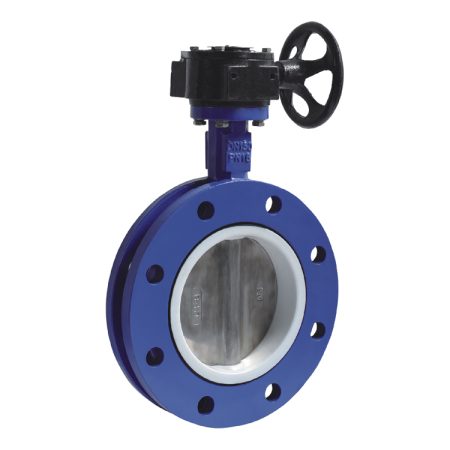
Importance of accurate measurements
Accurate measurements are essential during the installation of butterfly valves to ensure proper fit and function. Measuring accurately for dimensions such as face-to-face, flange size, and other critical parameters can prevent operational inefficiencies, safety hazards, and potential equipment failure. Precision is especially important in applications with high pressures or specialized fluid media. Obtaining precise measurements can be accomplished through the use of specialized tools such as calipers, micrometers, and ultrasonic thickness gauges. By taking accurate measurements, distributors can ensure that they protect their customers from potential safety or maintenance issues, satisfy compliance regulations, and meet the required industry standards. Ultimately, accurate measurements are a critical aspect of ensuring that butterfly valves function efficiently and effectively in their intended applications.
Tips for troubleshooting installation issues
If you encounter installation issues with a butterfly valve, several tips can help you troubleshoot the problem. Firstly, review the manufacturer’s installation instructions and ensure you’ve followed each step correctly. Secondly, check that the valve is compatible with the existing pipeline in terms of size, pressure, and fluid properties. Thirdly, inspect the valve’s shaft, disc, and seal to ensure there is no damage or deterioration. Fourthly, check for proper alignment and ensure that the valve and flanges are tight according to the manufacturer’s recommended torque specifications. Fifthly, ensure that there are proper gaskets and seals installed, and they are correctly positioned. Lastly, verify the valve’s position and ensure the flow direction matches the arrow on the valve body. Troubleshooting installation issues can be time-consuming; however, following these tips can help identify and solve the problem promptly, so butterfly valves function as designed, avoiding expensive downtime or maintenance costs.
Other valve considerations
In addition to selecting the correct butterfly valve size, dimensions, and installation procedures, there are other important considerations to the valve’s operation. These include the valve’s operating temperature range, fluid compatibility, and the valve’s intended use. Butterfly valves must operate within a specific temperature range to prevent damage to the valve components or potential safety hazards. Variations in fluid properties and compatibility can lead to corrosion, erosion, or valve damage, affecting valve performance. Knowing the fluid’s viscosity, density, and other properties such as flow rate and pressure is crucial in selecting the appropriate butterfly valve. Lastly, understanding the application’s needs and the purpose of the valve can help in making the right choice of butterfly valve. By considering all these factors, distributors can offer their customers the best butterfly valve options to meet their specific needs, resulting in optimal performance and preventing potential hazards that may require repairs or replacements.
Differences between butterfly valves and other valve types
Butterfly valves differ from other valve types in several ways. Unlike ball valves, the flow control element in a butterfly valve rotates around a central axis instead of floating or resting on a seat. In contrast, gate valves use a linear motion to open and close, while globe valves use a reciprocating plug or disk. Butterfly valves are generally more compact than globe or gate valves due to their reduced number of parts and simpler design, allowing them to fit into tighter spaces. Another difference is that butterfly valves are usually less expensive and lighter than globe or gate valves, making them a popular choice for large applications with several valves needed. However, gate valves are better suited for applications with high pressure and high-temperature operations, while globe valves offer more precise throttling capabilities. Each of these valve types has its benefits and drawbacks, and selecting the right valve type is crucial for optimal performance and safety in a specific application.
Additional factors for selecting butterfly valves
In addition to the standard dimensions, compatibility, and installation procedures, other factors should also be considered when selecting butterfly valves. One of the most critical factors is the pressure range in which the valve will be operating. It’s important to select a valve that can handle the required pressure range for the application without compromising the valve’s integrity or posing potential safety hazards. The type of fluid medium must also be taken into account, including the temperature range, corrosiveness, and viscosity, among others. Environmental factors such as vibrations, shocks, and exposure to chemicals, for example, should also be considered when choosing the most suitable butterfly valve for a specific application. Finally, the system’s flow rates and expected flow characteristics must also be taken into account to ensure that the valve will be able to handle the required flow rates and perform optimally in the particular application. Considering all these factors will lead to choosing the best butterfly valve for a given application, thus ensuring optimal performance and preventing subsequent problems that may require repairs or replacements.
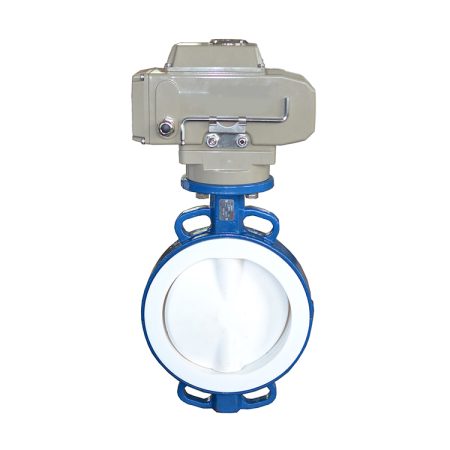
Conclusion butterfly valve face to face dimensions
In conclusion, the standard butterfly valve face-to-face dimensions are an essential consideration when selecting, installing, and maintaining butterfly valves in pipeline systems. The dimensions ensure compatibility with the existing pipeline system and contribute to efficient fluid flow and optimal performance. It’s essential to select the right dimension and size depending on the pipeline diameter to minimize potential safety hazards, avoid inefficiencies in flow regulation, and reduce any maintenance and repair costs that may arise from using incorrect dimensions.
The American National Standards Institute (ANSI) and the International Organization for Standardization (ISO) have set standards for the dimensions of butterfly valves, face-to-face dimensions, and flange types. Understanding these standards helps to ensure that the butterfly valves used in a particular application meet the required industry requirements and achieve optimal performance reliability.
When selecting butterfly valves for your pipeline system, consider factors like the fluid medium, operating temperature, pressure range, flow rate, and characterization of the surrounding environment. Selecting the right butterfly valve requires a good understanding of the valve’s application needs, and proper installation practices must be followed to ensure optimal performance.
In conclusion, butterfly valves provide an efficient and cost-effective means of regulating fluid flow in pipeline systems. The standard face-to-face dimensions ensure that the valve is compatible with the existing pipeline, allowing for efficient performance and longevity. With the right valve selection, installation procedures, and regular maintenance, distributors can ensure that they offer their customers quality products that meet the required standards for optimal performance and longevity.
Recap of key points butterfly valve face to face dimensions
Recapping the key points regarding standard butterfly valve face-to-face dimensions, selecting the right dimension and size is crucial during installation. Proper sizing and selection ensure compatibility with the existing pipeline and promote efficient fluid flow, preventing operational inefficiencies, maintenance needs, and costly downtime. The American National Standards Institute (ANSI) and the International Organization for Standardization (ISO) have set dimensions for butterfly valves, face-to-face dimensions, and flange types to meet industry requirements. Understanding other considerations such as pressure range, fluid compatibility, and valve’s intended use are also essential. Therefore, selecting the right butterfly valve requires a good understanding of the valve’s application needs, and following proper installation procedures and regular maintenance practices, ensure optimal performance and longevity of the valve system.
Importance of utilizing standard butterfly valve dimensions
Utilizing standard butterfly valve dimensions is essential when selecting and installing butterfly valves in pipelines. Standards set by organizations such as ANSI and ISO ensure compatibility of the valve with the pipeline system, allowing for optimal performance and efficient fluid flow. By adhering to the standard dimensions, distributors can offer their customers quality products that meet industry requirements and perform reliably in their intended applications. Standard dimensions also ensure that replacement pneumatic valves can be easily sourced and installed in the case of repairs or replacements. Adhering to standard dimensions avoids unnecessary costs that may result from using incorrect dimensions, promotes safety, increases productivity, and extends the lifespan of the valve system.
Final thoughts on proper installation and maintenance.
Proper installation and maintenance play a crucial role in achieving optimal performance and prolonging the lifespan of butterfly valves. Installing butterfly valves correctly not only ensures efficient fluid flow but also reduces the risks of potential hazards, such as leaks or valve failure. Following recommended installation procedures, such as confirming compatibility with existing pipelines, obtaining accurate measurements, and aligning the valve correctly, minimizes the need for subsequent maintenance or repairs. Regular maintenance of butterfly valves also ensures that they are operating efficiently and within the required specifications. Maintenance practices such as inspecting the valve components for damage, proper lubrication, and cleaning can prevent equipment failure, extending the valve’s lifespan and minimizing the potential for downtime. In conclusion, proper installation, and regular maintenance practices are necessary to ensure the longevity, efficiency, and reliable operation of butterfly valves in their intended applications.

